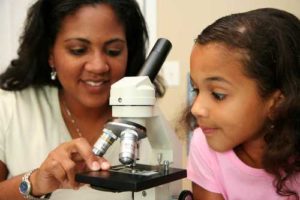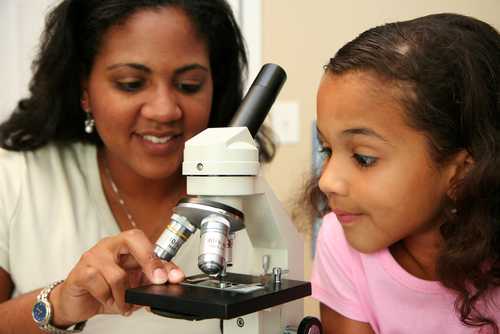Get outside, involve the community, and take stock of your resources to improve STEM outcomes, says one PD organization
 The quest to improve the way schools team STEM subjects, such as engineering and computer science, isn’t an easy fix. New resources, technology, and teacher training all play a significant part.
The quest to improve the way schools team STEM subjects, such as engineering and computer science, isn’t an easy fix. New resources, technology, and teacher training all play a significant part.
Recently, school administrators shared how they were tackling the problem at the elementary level, using professional development courses from the National Center for STEM Elementary Education at St. Catherine University in Minnesota. To help other schools, the NCSEE has also come up with a ten-point tip sheet for schools looking to beef up their commitment to STEM.
“The thing that’s most universally true is that schools and teachers are so full of opportunities to teach STEM. There’s so much right there already,” said Patty Born-Selly, the executive director of the NCSEE. “What we’ve found across the board is that teachers really want to be more comfortable with this material and the subject matter so they feel as comfortable with it as, say, reading.”
Among the organization’s suggestions: be realistic, involve local professionals from the community, survey local outdoor areas, and take time to celebrate STEM successes in a way that joins together the entire school. Read on for the NCSEE’s full suggestions.
Next page: 10 steps to improve your approach to teaching STEM
1. KNOW YOUR OWN EXPERTISE IN SCIENCE, TECHNOLOGY, ENGINEERING, AND MATHEMATICS. What are your strengths? Where does your school already shine? Capitalize on your current areas of strength and build from there. Identify your most enthusiastic teachers –they will be a source of support and inspiration.
2. NAME YOUR GOALS. Why do you want to be a STEM school? What do you believe it will allow you to do for students that you are not already doing? What will students walk out of your school knowing how to do and understand?
3. IDENTIFY YOUR PHYSICAL RESOURCES. Consider your existing resources. Do you have a computer lab shared by the whole school, or tablets for each student? Is your school’s media center a rich source of information? Is your school located near a natural area that could serve as an outdoor classroom?
4. IDENTIFY YOUR HUMAN RESOURCES. Who are the experts you may reach out to? Consider corporations, parents, professional organizations. What funding do you have available? What are the parents in your school community willing to do to support you?
5. KNOW THAT STEM IS A SPECTRUM. You don’t have to “do it all” from day one. Building a strong STEM school takes time! Start with reasonable, measurable outcomes. Maybe you want to start by offering one STEM course for one grade level, with the ultimate goal being to integrate STEM into every course? Define a series of steps you can take to reach your desired level of STEM integration.
6. PLAN FOR THE NEXT LEVEL. Identify and plan the next steps needed to reach your goal. Be constantly thinking about new ways to grow, deepen, and integrate STEM so that your students have every advantage in the future.
7. ENGAGE YOUR COMMUNITY IN THE PROCESS. Hold science expos, engineering nights, technology challenges, and math activity days for the parents and other community members. When they learn how important, accessible, and fun STEM can be they will be better able to support your school.
8. LEVERAGE PROFESSIONAL CONNECTIONS. See if you, your staff, or anyone from your school community has a connection (or can make one) with a STEM professional society (e.g National Science Teachers’ Association, American Mathematical Society) and if they do outreach or school sponsorship.
9. OBTAIN PROFESSIONAL DEVELOPMENT. Any kit or curriculum guide is only as good as the teacher who delivers it, so be sure to have a plan for continuous professional development in STEM helping teachers go deeper, expand to different topics, and learn different ways to integrate STEM into the classroom. Consider how to integrate STEM across content areas.
10. BASK IN YOUR STUDENTS’ SUCCESS. Have yearly events where faculty, staff, and students can celebrate their learning and accomplishments in STEM over the year. This is essential for keeping everyone in your school eager and excited about your new STEM identity.
- TC- What student choice and agency actually looks like - November 15, 2016
- What student choice and agency actually looks like - November 14, 2016
- App of the Week: Science sensor meets your smartphone - November 14, 2016

